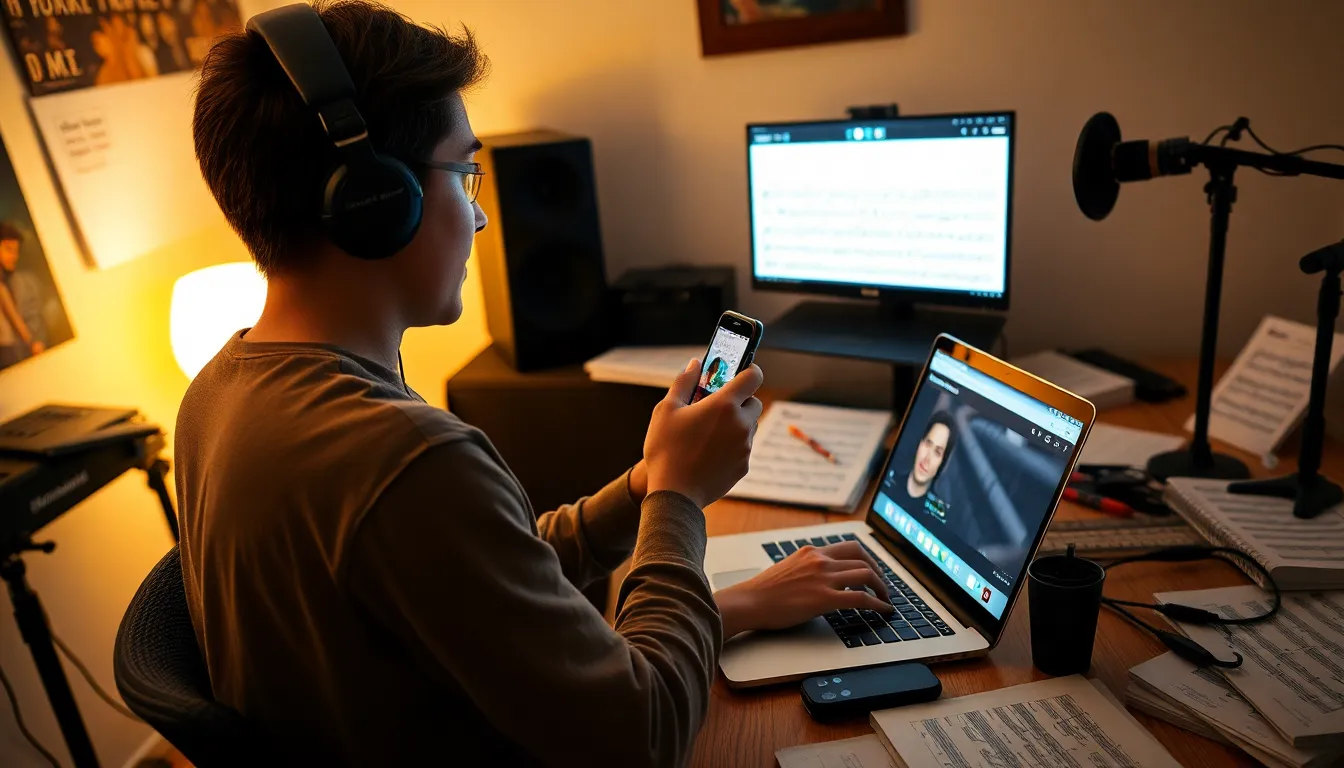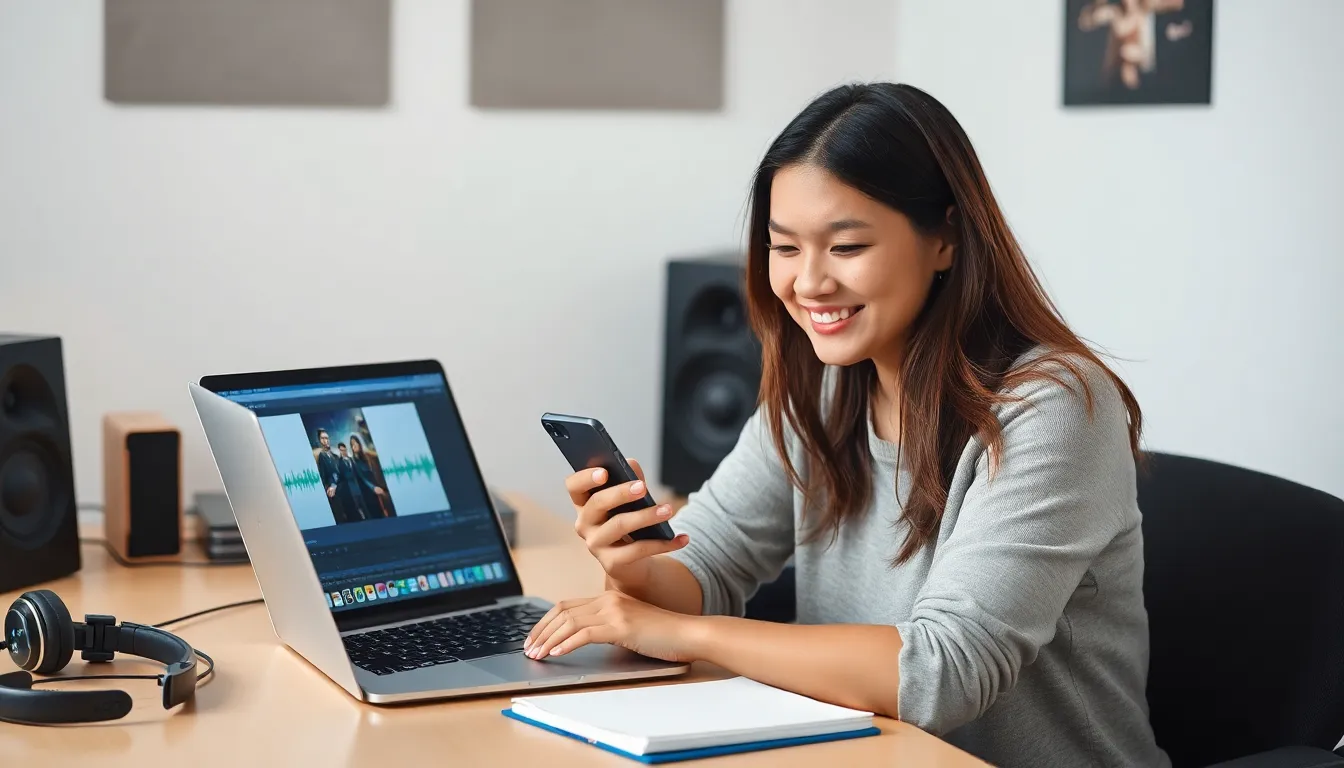Imagine this: your phone rings, and instead of the usual bland tone, it blares out your favorite song or an inside joke that never fails to crack you up. Sounds tempting, right? The good news is, with a little creativity and some clever tricks, you can turn that dream into a reality.
Table of Contents
ToggleCan You Record A Ringtone On iPhone?
Recording a ringtone on an iPhone is possible, but it requires specific steps. Users must first gather the audio file they wish to convert into a ringtone. Proficiency in audio editing apps, such as GarageBand, provides an advantage for this process.
GarageBand facilitates audio recording and editing for iPhone users. Access the app and create a new project. Import the desired audio file, trimming it down to a maximum of 30 seconds, which is the length limit for ringtones.
After editing, exporting the file as a ringtone is the next step. Navigate to the “Share” option within GarageBand. Select “Ringtone” and follow the prompts to save the file. This process makes the customized sound immediately available in the phone’s ringtone settings.
For those without GarageBand, iTunes provides an alternative method for recording ringtones. Users can transfer an audio file to their computer, open it in iTunes, and adjust the duration. Setting the ring tone length limit helps ensure compatibility with the iPhone.
After creating a ringtone in iTunes, syncing the device allows for direct access. This process creates a seamless transition from computer to phone, enabling users to personalize their ringtones effectively.
Additional apps on the App Store also allow ringtone creation. These apps often specialize in quick edits and user-friendly interfaces. Each option provides unique features catering to different levels of expertise in audio editing.
Recording your own ringtone enhances personalization and showcases individuality. With the right tools at hand, anyone can craft a distinctive ringtone experience.
Methods For Recording Ringtones

Recording personalized ringtones on an iPhone offers various approaches. Discover the methods that best suit your needs.
Using Third-Party Apps
Numerous third-party apps simplify the ringtone creation process. Applications like Ringtone Maker and Zedge allow users to select songs from their library, trim audio clips, and save them as ringtones. Users can follow straightforward steps within these apps, making the task accessible. The intuitive interfaces ensure even those with minimal technical skills can navigate easily. Once the ringtone is set, users can seamlessly add the customized tone to their iPhone settings.
Using GarageBand
GarageBand provides an effective way to record ringtones on an iPhone. To start, users need to download the GarageBand app from the App Store. Next, they can import their desired audio file and trim it to a maximum length of 30 seconds. GarageBand’s editing features allow for adjustments and enhancements, such as adding effects. After editing, users can export the audio file as a ringtone directly through the app. The user-friendly nature of GarageBand makes it a popular choice for creating personalized ringtones effortlessly.
Steps To Create A Ringtone
Creating a ringtone on an iPhone involves clear steps, making the process straightforward and enjoyable. Below are key stages to successfully craft a personalized ringtone.
Choosing The Right Sound
Selecting the perfect sound is crucial. Users often prefer their favorite songs or specific audio clips that hold personal significance. Identify tracks that evoke emotions or memories. Many apps provide access to popular songs and sound bites, allowing users to explore a variety of options. To check for copyright restrictions, review the licensing agreements for any track. Remember, shorter clips often work best for ringtones, making it easier to trim longer pieces to fit the 30-second limitation.
Editing The Audio
Utilizing editing tools enhances the audio experience. Users can import audio files into apps like GarageBand or iTunes for editing. First, trim the audio down to the desired length, keeping it under 30 seconds. Adjusting the volume and applying fade-in or fade-out effects contributes to a polished sound. Once edited, export the audio file as a ringtone. Many third-party apps also simplify this process, enabling easy trimming and saving options. With these tools, creating a professional-sounding ringtone becomes effortless.
Syncing Ringtones To iPhone
Syncing ringtones to an iPhone ensures that personalized tones become available on the device. Users can utilize iTunes or Finder for this task.
- Open iTunes or Finder: Launch iTunes on a PC or Finder on a Mac to begin the synchronization process.
- Connect iPhone: Use a USB cable to connect the iPhone to the computer. Trust the computer if prompted on the iPhone screen.
- Select Device: Click the iPhone icon in iTunes or Finder. This action directs users to the device summary page.
- Drag Ringtones: Locate the recorded ringtones in the library and drag them into the “Tones” section of the iTunes or Finder window.
- Sync Ringtones: Check the box next to “Sync Tones” to include ringtones in the sync process.
- Apply Changes: Click “Apply” or “Sync” to transfer the selected ringtones to the iPhone.
After completing these steps, ringtones should appear in the iPhone’s settings. Users can head to Settings, then Sounds & Haptics, and select Ringtone to choose the newly synced tones.
Third-party apps like GarageBand or Ringtone Maker streamline this process further. These apps sometimes offer direct synchronization capabilities, reducing reliance on iTunes or Finder. Additionally, ensuring audio files adhere to the 30-second limit is critical for successful syncing.
By following these straightforward instructions, users can effortlessly import and access custom ringtones on their iPhones. This personalization reflects individual tastes and preferences, enhancing the overall experience.
Tips For Successful Ringtone Recording
Choosing the right environment fosters high-quality recordings. Select a quiet space, free from background noise, to capture crisp sound.
Utilizing quality audio editing apps enhances the final product. GarageBand remains a popular option, offering various features for trimming and adjusting sound.
Focusing on sound clips that evoke positive feelings often leads to more meaningful ringtones. Emotional tracks improve user satisfaction when hearing them daily.
Paying attention to the 30-second limit is crucial. Adhering to this maximum duration ensures compatibility with iPhone ringtone settings.
Experimenting with different edits and effects provides unique touches. Users can adjust volume levels, add fades, or apply filters to achieve a polished sound.
Testing ringtones before syncing guarantees that they sound as intended. Listening to the edited version helps identify any final adjustments needed.
Following sync instructions carefully avoids frustration during the transfer process. Connecting the iPhone to a computer and navigating through iTunes or Finder ensures a smooth final step.
Keeping track of copyright limitations is essential. Users must choose music clips that allow personal use to avoid legal complications.
Creating backups of custom ringtones prevents loss during app updates. This practice ensures that personal creations remain accessible over time.
Using third-party apps simplifies the ringtone creation process. Many apps on the App Store allow users to select songs and save them directly as ringtones with minimal effort.
Recording a ringtone on an iPhone is a straightforward process that allows users to express their individuality. With tools like GarageBand and various third-party apps available on the App Store, creating a personalized ringtone becomes an enjoyable experience.
By following the outlined steps and tips, anyone can craft a unique sound that resonates with their preferences. Whether it’s a favorite song or a memorable audio clip, the possibilities for customization are endless.
Embracing these methods not only enhances the phone experience but also brings a touch of personal flair to everyday notifications.




